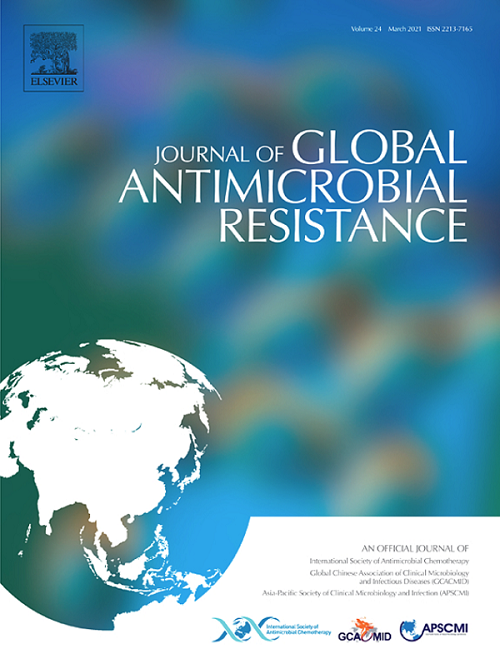2019冠状病毒病对泰国三级医院耐碳青霉烯鲍曼不动杆菌血流感染患者流行病学和死亡危险因素的影响
IF 3.2
3区 医学
Q2 INFECTIOUS DISEASES
引用次数: 0
摘要
目的:了解2019冠状病毒病疫情期间鲍曼不动杆菌分离株及血流感染的流行病学。方法:对2019 - 2023年临床标本分离的鲍曼不动杆菌进行鉴定。描述了耐碳青霉烯类鲍曼杆菌(CRAB)的季度发病率。全院范围内碳青霉烯消耗量以限定日剂量(DDD)量化。确定了螃蟹感染的危险因素和螃蟹性脑梗死患者30天全因死亡率。结果:共发现400例螃蟹新病例。临床分离总阳性率呈波动趋势(P = 0.68),临床分离总阳性率呈上升趋势(P = 0.04)。螃蟹发病率与全院碳青霉烯类药物用量无相关性(P = 0.93)。螃蟹BSI 75例,非耐碳青霉烯类鲍曼不动杆菌(NCRAB) BSI 47例。既往抗生素暴露(aOR 8.67;P < 0.001)和90天内存在多药耐药菌(MDROs) (aOR 4.63;P = 0.02)与CRAB BSI获取显著相关。螃蟹性脑梗死患者的30天死亡率(66.67%)高于NCRAB性脑梗死患者(25.53%)(aHR 0.83, 95% CI 0.26-2.59;P = 0.74)。皮特菌血症评分(aHR 1.20;P = 0.01)和近期COVID-19感染(aHR 2.86;P = 0.03)是螃蟹性脑梗死死亡率的独立预测因子。结论:螃蟹临床分离株总发病率呈波动趋势,而螃蟹BSIs发病率明显升高。既往抗菌药物暴露和90天内存在mdro是螃蟹的危险因素。皮特菌血症评分和最近的COVID-19感染与较高的CRAB BSI死亡率有关。本文章由计算机程序翻译,如有差异,请以英文原文为准。
Impact of COVID-19 on epidemiology and mortality risk factors in patients with carbapenem-resistant Acinetobacter baumannii bloodstream infections in a tertiary care hospital in Thailand
Objective
To investigate the epidemiology of Acinetobacter baumannii isolates and bloodstream infections (BSIs) during the COVID-19 pandemic.
Methods
A. baumannii isolated from clinical specimens were identified between 2019 and 2023. The quarterly incidence of carbapenem-resistant A. baumannii (CRAB) was described. Hospital-wide carbapenem consumption was quantified as defined daily doses (DDD). Risk factors for CRAB acquisition and 30-day all-cause mortality in CRAB BSIs were determined.
Results
A total of 400 new CRAB cases were identified. The incidence of total CRAB clinical isolates fluctuated (P = 0.68), while the incidence of CRAB BSIs increased (P = 0.04). No correlation was found between CRAB incidence and hospital-wide carbapenem consumption (P = 0.93). There were 75 CRAB BSI cases and 47 non-carbapenem-resistant A. baumannii (NCRAB) BSI cases. Prior antibiotic exposure (aOR 8.67; P < 0.001) and presence of multidrug-resistant organisms (MDROs) within 90 days (aOR 4.63; P = 0.02) were significantly associated with CRAB BSI acquisition. CRAB BSIs had higher 30-day mortality (66.67%) than NCRAB BSIs (25.53%) (aHR 0.83, 95% CI 0.26–2.59; P = 0.74). Pitt bacteremia score (aHR 1.20; P = 0.01) and recent COVID-19 infection (aHR 2.86; P = 0.03) were independent predictors of mortality in CRAB BSIs.
Conclusions
The incidence of total CRAB clinical isolates fluctuated, while the incidence of CRAB BSIs significantly increased. Previous antimicrobial exposure and presence of MDROs within 90 days were risk factors for CRAB. Pitt bacteremia score and recent COVID-19 infection were linked to higher CRAB BSI mortality.
求助全文
通过发布文献求助,成功后即可免费获取论文全文。
去求助
来源期刊

Journal of global antimicrobial resistance
INFECTIOUS DISEASES-PHARMACOLOGY & PHARMACY
CiteScore
8.70
自引率
2.20%
发文量
285
审稿时长
34 weeks
期刊介绍:
The Journal of Global Antimicrobial Resistance (JGAR) is a quarterly online journal run by an international Editorial Board that focuses on the global spread of antibiotic-resistant microbes.
JGAR is a dedicated journal for all professionals working in research, health care, the environment and animal infection control, aiming to track the resistance threat worldwide and provides a single voice devoted to antimicrobial resistance (AMR).
Featuring peer-reviewed and up to date research articles, reviews, short notes and hot topics JGAR covers the key topics related to antibacterial, antiviral, antifungal and antiparasitic resistance.
 求助内容:
求助内容: 应助结果提醒方式:
应助结果提醒方式:


